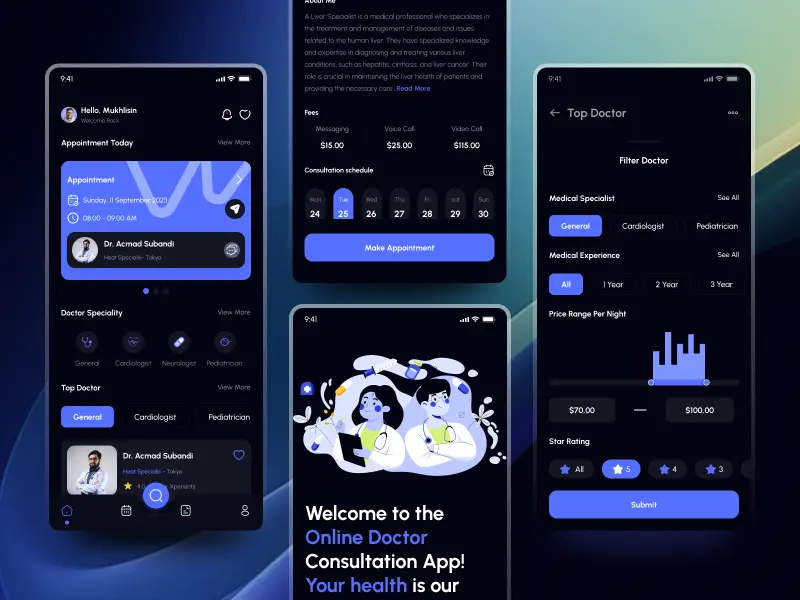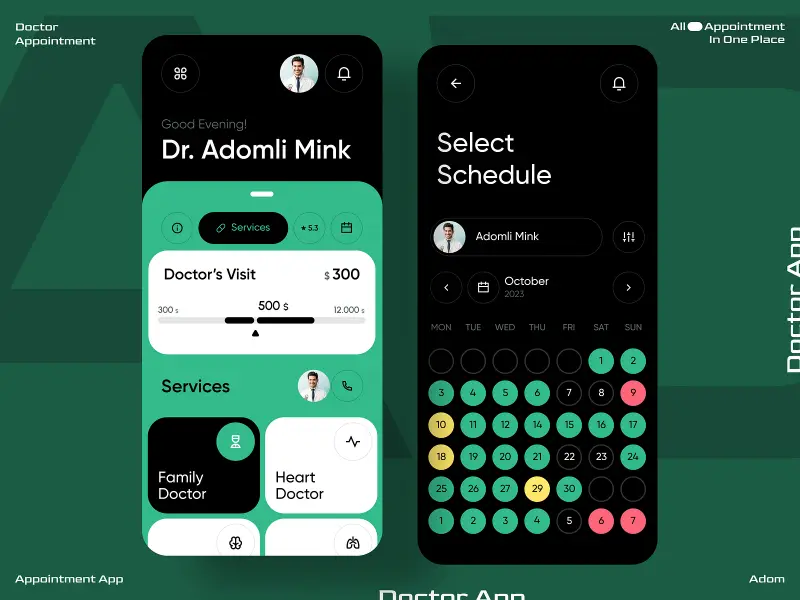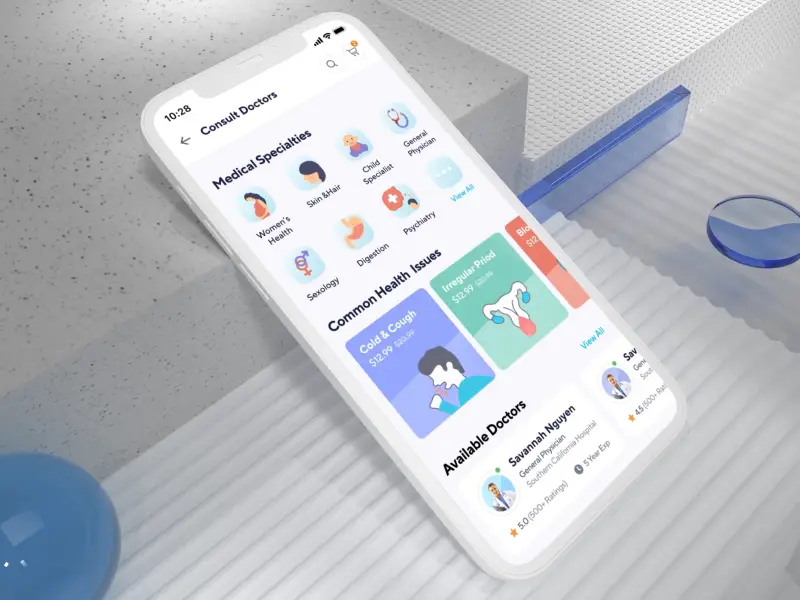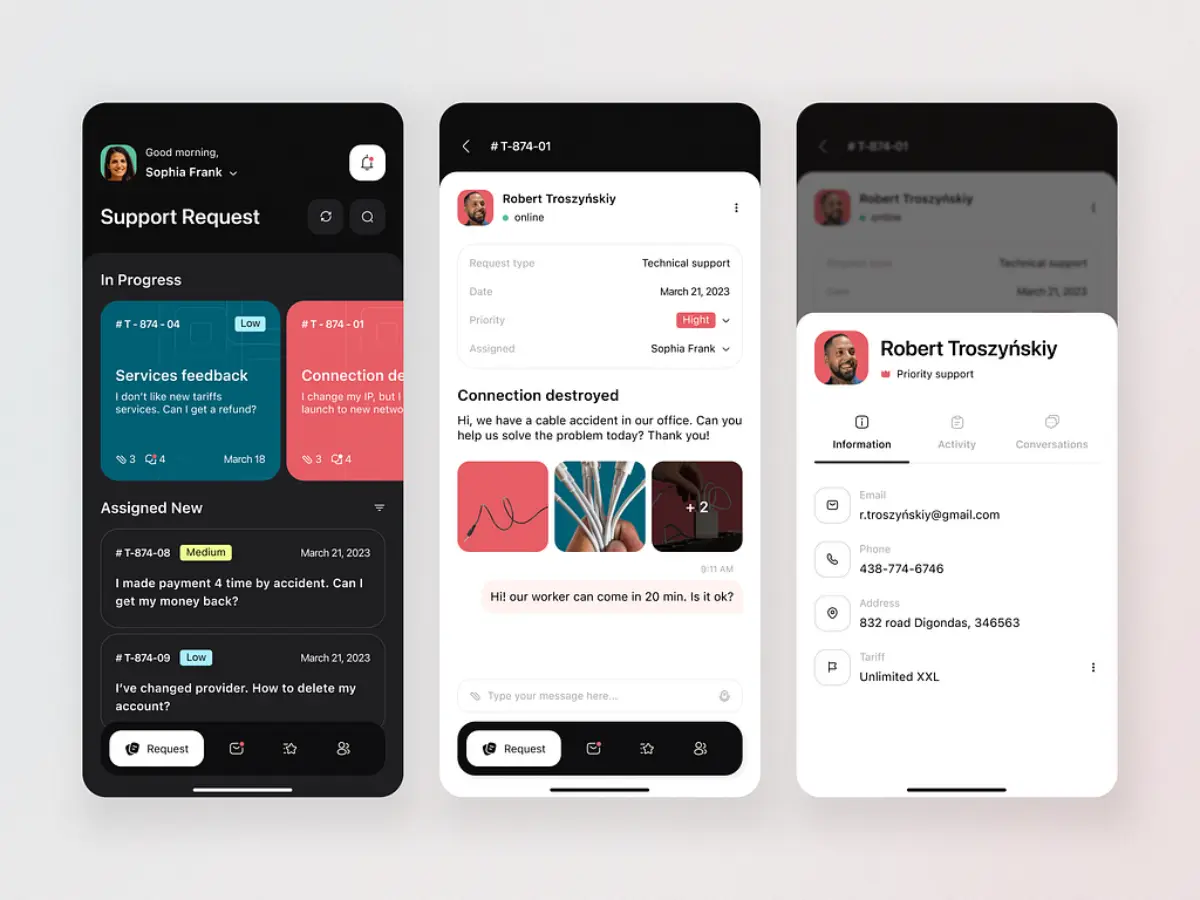Step-by-Step Guide to Doctor Appointment App Development
- TECHVIFY Team
- 0 Comments
The healthcare scheduling market is booming—valued at $151.42 billion in 2023 and expected to hit $290 billion by 2028. The COVID-19 pandemic sparked this growth, making online doctor appointment apps essential with features like remote consultations, multilingual support, and travel insurance integration.
Over 80% of app users started during the pandemic, and the trend continues—43% of adults still rely on these apps today.
If you’re considering doctor appointment app development, now is the perfect time to tap into this booming market. Whether starting a new venture or enhancing hospital services, this guide covers tips, business models, and industry insights to help you create a successful solution. Let’s dive in!
TL;DR: Successful doctor appointment apps include features like appointment scheduling, secure messaging, and telemedicine. Major challenges include maintaining healthcare compliance, ensuring scalability, integrating third-party APIs, and creating an intuitive design.
I. Market Overview of Doctor Appointment Apps
Doctor appointment apps have become a cornerstone of the healthcare and fitness app industry, offering convenience and efficiency for both patients and providers. Here’s what recent surveys and market data reveal about this growing sector:
- 25% of patients now prefer to book appointments online.
- 72% of patients and 60% of healthcare professionals agree that online booking platforms improve appointment adherence.
- 52% of users rely on their smartphones for health-related queries.
- 40% of physicians consider digital healthcare technology a key factor in reducing unnecessary in-person visits.
- The global online doctor consultation market was valued at $21.9 billion in 2022 and is projected to grow to $35.41 billion by 2027, with a CAGR of 10.01%.
With stats like these, it’s clear why hospitals and healthcare providers should invest in doctor appointment booking app development to streamline scheduling and enhance patient care. Platforms like Zocdoc have already established themselves as leaders in this space, benefiting from the growing adoption and trust of stakeholders across the healthcare ecosystem.
Still want to see more Healthcare articles? Check here:
II. Guide to Doctor Appointment App Development
Doctor booking app development requires careful planning, robust features, and a focus on user-centric design to ensure success. While the process may seem complex, breaking it down into manageable steps ensures a streamlined development journey. Here’s how you can create a successful doctor appointment app:
Doctor appointment booking app development process
Step 1: Prepare Your Database
Think of your app as a marketplace where doctors and clinics are the key assets. To get started, you’ll need a comprehensive and reliable database of healthcare providers, including their specialties, clinic details, availability, and credentials.
If you don’t already have this database, make it your first priority. Partner with healthcare providers or clinics to gather accurate information and create a strong foundation for your platform. Without this, your app won’t have the key resource it needs to function effectively.
Step 2: Develop and Validate Your Prototype
Once you’ve organized your database, it’s time to bring your concept to life and develop a doctor appointment app prototype that visualizes key features and workflows. A prototype helps you visualize the user interface, features, and overall flow of your app.
- Include key screens, such as the registration page, doctor search, appointment scheduling, and payment gateway.
- Involve test users, including patients and medical professionals, to gather feedback on usability and functionality.
Validating your prototype ensures that you address any pain points early in the development process, saving time and resources later.
Step 3: Integrate Scheduling Tools
A reliable scheduling feature is the backbone of any doctor appointment app. Instead of building a scheduling engine from scratch, consider integrating a pre-built scheduling API.
Using an off-the-shelf API:
- Speeds up the development process.
- Ensures robust and tested functionality.
- Reduces the risk of errors in appointment management.
This allows you to focus on other custom features while ensuring smooth and efficient scheduling for users.
Step 4: Design an Intuitive UI/UX
A seamless and user-friendly design is crucial when you develop a doctor appointment booking app, as it engages the primary user groups: patients, doctors, and administrators. Each group interacts with the app differently, so their interfaces should be tailored to meet their specific needs.
- Patient Panel: Design a simple interface for searching doctors, booking appointments, and managing notifications.
- Doctor Panel: Include tools for managing schedules, viewing patient information, and sending appointment updates.
- Admin Panel: Focus on functionalities to oversee user activity, manage data, and handle app maintenance efficiently.
User-friendly design enhances engagement and ensures that users can navigate the app with ease, regardless of their technical expertise.
Step 5: Ensure Compliance with Healthcare Regulations
In healthcare, security and compliance are non-negotiable. Your app must adhere to regulations like HIPAA, GDPR, and the HITECH Act to protect sensitive patient information.
Key considerations for compliance:
- Data Encryption: Encrypt all Protected Health Information (PHI) both in transit and at rest.
- SSL Connections: Use secure connections to prevent data breaches.
- HIPAA-as-a-Service Platforms: Consider cloud services specifically tailored for HIPAA compliance.
- Regulatory Knowledge: Ensure your development team understands and implements all necessary compliance standards.
Failure to follow these regulations can result in hefty fines and loss of user trust, making compliance a top priority for any doctor appointment app development company.
Step 6: Conduct Thorough Testing
Your app isn’t ready to launch until it’s been rigorously tested—an essential step in successful doctor booking app development. Testing should begin during development and continue after key features are implemented.
What to test:
- Functionality: Ensure features like appointment scheduling, notifications, and payments work seamlessly.
- Security: Test for vulnerabilities and ensure data encryption and access controls are in place.
- Performance: Simulate high user traffic to identify potential bottlenecks.
- Compatibility: Test the app across various devices, screen sizes, and operating systems to ensure a consistent experience.
Comprehensive testing ensures your app is reliable, secure, and ready for real-world use.
Step 7: Launch and Maintain Your App
Once testing is complete, it’s time to launch your app. Releasing your app to app stores and making the web dashboard live is just the beginning.
To ensure long-term success:
- Regular Updates: Continuously add new features and improvements to keep up with user expectations.
- Support for New Devices/OS Versions: Update your app as new mobile devices and operating system versions are released.
- Bug Fixes: Act quickly on user feedback to address issues and improve functionality.
Post-launch maintenance is critical to keeping your app relevant, functional, and highly rated by users.
Have a Project Idea in Mind?
Get in touch with experts for a free consultation. We’ll help you decide on next steps, explain how the development process is organized, and provide you with a free project estimate.
III. Must-Have Features of a Doctor Appointment Booking App
Doctor appointment app development is about more than just scheduling—it’s about connecting patients and healthcare providers seamlessly while delivering a secure and user-friendly experience. Whether you’re building an app for patients, doctors, or both, the core features you include can make or break its success. Let’s explore the essentials with a tone that keeps things straightforward and actionable.
Easy User Registration and Profile Management
Think of the registration process as your app’s welcome mat. If it’s clunky or complicated, users will leave before they even get started. To make the experience seamless, your app should allow:
- Quick sign-up options (email, phone number, or social accounts).
- Profile creation where patients can add personal details, medical history, and even preferences.
- Editable profiles, so users can update their information whenever they need to.
For doctors, this feature should include the ability to manage their professional profiles, set their schedules, and provide essential details for patients upfront. A personalized, easy-to-use profile is the first step toward building trust and engagement.
Search and Filter: Help Patients Find the Right Doctor
No one likes scrolling endlessly to find what they need. A powerful search and filter feature is critical for helping patients quickly locate the right healthcare provider. Here’s what this feature should include:
- Search options for specialties (e.g., cardiologist, dermatologist), locations, languages, and availability.
- Advanced filters to fine-tune results (e.g., experience, ratings, or even gender preference).
- The ability to compare doctors side-by-side, so users can make informed decisions.
This isn’t just a convenience—it’s how you ensure patients feel confident they’re choosing the right care.
Develop a doctor appointment app
Detailed Doctor Profiles and Patient Reviews
When it comes to healthcare, trust is everything. Your app should offer comprehensive doctor profiles that include:
- Specialties, qualifications, years of experience, and clinic locations.
- Patient reviews and ratings to provide transparency.
- A section for doctors to share updates, tips, or practice information.
Allowing doctors to keep their profiles up to date and encouraging patients to leave honest reviews builds credibility for your app. It’s not just about information—it’s about creating a sense of connection between patients and providers.
Smooth Appointment Booking and Scheduling
At the heart of your app is its appointment scheduling system. Patients need this process to be simple and frustration-free. Here’s what works:
- An intuitive calendar interface that shows available slots clearly.
- Options to book, reschedule, or cancel appointments with ease.
- Real-time updates synced with doctors’ calendars to avoid double bookings.
Think of this feature as the engine of your app—if it’s unreliable or confusing, everything else falls apart.
Secure and Convenient Doctor-Patient Communication
It’s not always about the appointment itself—patients often need to ask follow-up questions or share test results. A secure messaging system is crucial for maintaining continuity of care.
Make sure this feature includes:
- Private, encrypted chats to protect sensitive health information.
- The ability to share documents or images, like test results or prescriptions.
This isn’t just about convenience; it’s about fostering trust by ensuring all communication is safe and confidential.
Video Conferencing and Telemedicine
Telemedicine is no longer a “nice-to-have”—it’s a must. A video conferencing feature allows patients to consult with doctors remotely, saving time (and trips).
This is especially useful for:
- Follow-up appointments that don’t require in-person visits.
- Minor health concerns or check-ins.
- Patients who live in rural areas or have mobility challenges.
By offering telemedicine, your app becomes a more versatile tool for modern healthcare needs.
Appointment Notifications and Reminders
Let’s face it—people forget appointments. That’s where notifications and reminders come in. This feature is a game-changer for reducing no-shows and keeping patients on track.
How it works:
- Send reminders for upcoming appointments via push notifications, SMS, or email.
- Allow users to customize notification preferences (e.g., how far in advance they want a reminder).
With missed appointments costing the healthcare industry billions every year, this small feature makes a big impact.
Appointment History and Analytics
Patients often need to refer back to previous consultations. An appointment history section allows them to:
- View past visits, treatments, and prescriptions.
- Track their healthcare journey over time.
For doctors, this feature can provide valuable insights into patient trends, helping them deliver better care and optimize their schedules.
Pharmacy and e-Prescribing (eRx) Management
Managing prescriptions can be a pain point for patients and doctors alike. Your app can simplify this process with features like:
- Digital prescriptions that patients can view anytime.
- Integration with pharmacies for direct prescription fulfillment.
- Medication reminders to help patients stick to their treatment plans.
By making prescriptions easier to manage, your app becomes a tool for better health outcomes.
Flexible Payment Options
Nobody wants to wrestle with payment issues after booking an appointment. A checkout system with multiple payment options ensures a smooth experience.
Include:
- Credit/debit cards, Apple Pay, Google Pay, and bank transfers.
- Wallet systems for storing and managing balances.
The easier it is for patients to pay, the more likely they are to complete their bookings—and return to your app.
Transparent Billing and Invoicing
Patients appreciate transparency, especially when it comes to costs. A billing feature should offer:
- Automated invoices after appointments, detailing services and charges.
- A clear, itemized breakdown of fees.
For healthcare providers, this feature reduces administrative work and ensures patients understand exactly what they’re paying for. It’s a win-win.
User Support That Actually Helps
Even the best apps run into issues. That’s why user support is a must-have.
What to include:
- A FAQ section for common questions.
- Live chat support for immediate help.
- A helpdesk ticket system for more complex issues.
Great support isn’t just about solving problems—it’s about showing users you care.
Bonus: Health Monitoring and Symptom Checker
For an extra layer of functionality, consider adding health monitoring tools. Patients can:
- Track key health indicators, like blood pressure or glucose levels.
- Use a symptom checker to get preliminary guidance and find the right doctor.
These features empower users to take charge of their health, making your app even more indispensable.
More Healthcare-related insights here:
IV. Key Challenges in Doctor Appointment App Development
Building medical scheduling software can be tricky, with challenges that, if ignored, can lead to serious consequences. Here’s a concise look at the key hurdles and how to tackle them.
Ensuring Data Security and User Privacy
The Problem: Patient data is highly sensitive, and breaches can lead to legal penalties, loss of trust, and financial damage. Regulations like HIPAA and GDPR require strict compliance.
Risks:
- Data breaches expose personal and medical information.
- Non-compliance with laws results in hefty fines.
- Patients lose confidence in your app’s security.
Solution:
- Adhere to HIPAA standards to safeguard data.
- Use encryption (SSL/TLS) for secure transmissions and storage.
- Implement multifactor authentication (MFA) to restrict unauthorized access.
Implementing a Payment System
The Problem: Payment systems are essential but can expose financial data to theft or fraud if not properly secured. Supporting multiple payment options is also a challenge.
Risks:
- Financial data breaches lead to fraud and loss of trust.
- Non-compliance with PCI DSS causes legal issues.
- Limited payment options frustrate users.
Solution:
- Support diverse payment options (cards, Apple Pay, Klarna, etc.).
- Ensure PCI DSS compliance for secure transactions.
- Partner with trusted payment gateways to handle sensitive data.
Doctor appointment booking app development
Designing a User-Friendly UI/UX
The Problem: A complex or inaccessible design alienates users, especially those with limited tech skills or disabilities. A bad interface leads to high abandonment rates.
Risks:
- Poor design frustrates users and reduces retention.
- Excluding disabled users shrinks your audience and violates accessibility laws.
- Negative reviews damage your app’s reputation.
Solution:
- Simplify navigation and keep the design clean.
- Prioritize accessibility with features like screen readers and font adjustments.
- Test usability with diverse user groups to refine the design.
Managing Scalability and Performance
The Problem: As your app grows, it must handle more users and data. Without scalability, performance issues like slow load times or crashes can arise.
Risks:
- Downtime disrupts appointments and frustrates users.
- Poor performance drives users to competitors.
- Inability to scale limits your app’s growth potential.
Solution:
- Use cloud-based architecture for scalable infrastructure.
- Run load tests to identify and resolve bottlenecks.
- Optimize backend systems for faster data processing.
Integrating with Third-Party Systems
The Problem: Healthcare apps rely on integrations with calendars, EHRs, payment systems, and telemedicine tools. Poor integration can cause data mismatches and workflow disruptions.
Risks:
- Inconsistent data leads to scheduling errors.
- Lack of integration reduces functionality, making the app less competitive.
- Delayed integration can increase costs and development time.
Solution:
- Use reliable APIs for seamless integration.
- Test thoroughly to ensure data flows smoothly.
- Plan integration early in the development process.
Conclusion
The healthcare scheduling market is growing rapidly, and the demand for reliable, user-friendly doctor appointment apps is higher than ever. With the right features like telemedicine, secure messaging, and intuitive scheduling tools, your app can become a game-changer for both patients and healthcare providers.
However, building such a platform comes with its own set of challenges—ensuring compliance, implementing secure payment systems, and creating a seamless user experience. That’s why having the right development partner is crucial to turning your vision into a reality.
Whether you’re launching a new app or upgrading an existing one, TECHVIFY is the doctor appointment app development company you can trust to bring your vision to life. From ideation to deployment, we specialize in creating scalable, compliant, and user-friendly healthcare solutions tailored to your needs. Contact TECHVIFY today for a free consultation and elevate your healthcare app development to the next level.
TECHVIFY – Global AI & Software Solution Company
From Startups to Industry Leaders: TECHVIFY prioritizes results, not just deliverables. Accelerate your time to market and see ROI early with high-performing teams, AI (including GenAI) Software Solutions, and ODC (Offshore Development Center) services.
- Email: [email protected]
- Phone: (+84)24.77762.666








